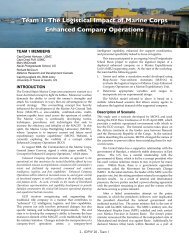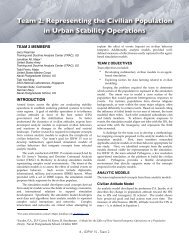pdf file - SEED Center for Data Farming - Naval Postgraduate School
pdf file - SEED Center for Data Farming - Naval Postgraduate School
pdf file - SEED Center for Data Farming - Naval Postgraduate School
Create successful ePaper yourself
Turn your PDF publications into a flip-book with our unique Google optimized e-Paper software.
Team 16: Logistics Battle Command Model<br />
TEAM 16 MEMBERS<br />
MAJ Francisco Baez<br />
U.S. Army Training and Doctrine Command Analysis <strong>Center</strong><br />
in Monterey, USA<br />
Mr. Jonathan Shockley<br />
U.S. Army Training and Doctrine Command Analysis <strong>Center</strong><br />
in Fort Lee, USA<br />
CDR Carston Sultz, GER NAVY<br />
<strong>Naval</strong> <strong>Postgraduate</strong> <strong>School</strong><br />
Overview<br />
This working group explored the use of the newly<br />
developed Logistics Battle Command (LBC) model<br />
prototype Graphical User Interface (GUI). Team 16 focused<br />
on the development and implementation of a logistics<br />
scenario designed to assess the operational impact of<br />
different strategies <strong>for</strong> the management and allocation of<br />
transportation assets. Particularly, the specific objectives of<br />
Team 16 sessions during IDFW 20 included:<br />
• Implement the scenario in LBC.<br />
• Use visualization features of the GUI to build and<br />
analyze the scenario.<br />
• Use the analysis features of the GUI to understand the<br />
output results.<br />
• Report the findings.<br />
LBC MODEL<br />
The LBC model is a low-resolution, object oriented,<br />
stochastic, discrete event model programmed in Java that<br />
incorporates Simkit as the simulation engine. LBC serves as<br />
a stand-alone analysis tool or as a dynamic logistics module<br />
that can be fully integrated into an existing combat model.<br />
LBC functionality includes planning and decision support<br />
features to enable a simulated sustainment decision maker to<br />
monitor the logistics common operating picture, <strong>for</strong>ecast<br />
demand <strong>for</strong> most classes of supply, and initiate and adjust<br />
missions to distribute supplies and per<strong>for</strong>m sustainment<br />
functions. LBC uses network architectures to represent the<br />
distribution pipeline to summon sustainment planning and<br />
execution representing the end-to-end flow of resources from<br />
supplier to point of consumption. LBC accomplishes this<br />
overall representation through three layers of network<br />
representation: the transportation, communications, and<br />
planning networks.<br />
The bottom layer is the transportation network. This<br />
layer links the LBC model to the physical area of operations<br />
representing the geographical distribution of supplies.<br />
Algorithms within LBC generate missions including<br />
determining the best methods and routes <strong>for</strong> transporting<br />
supplies to the end user while accounting <strong>for</strong> changing<br />
battlefield conditions.<br />
The middle layer is the communications network. This<br />
layer represents an arbitrarily complex communications<br />
network of the distribution system linking leaders and<br />
Soldiers to all applicable stakeholders including the logistics<br />
common operating picture. It carries the data of the<br />
distribution system in<strong>for</strong>mation network and links the<br />
planning and transportation layers in the LBC.<br />
The top layer is the planning network. This layer<br />
represents the data of the distribution system in<strong>for</strong>mation<br />
network. The planning network in LBC allows <strong>for</strong> monitoring<br />
any deviations between the sustainment execution and the<br />
sustainment plan, and also allows <strong>for</strong> sustainment replanning.<br />
LBC uses a task network to link the sustainment<br />
planning to execution.<br />
The current LBC version is the result of substantial<br />
revisions and expansion by the U.S. Army Training and<br />
Doctrine Command Analysis <strong>Center</strong> to improve the<br />
functionality and usability of the model as an analysis tool. To<br />
bridge the gap between scripted logistics planning and<br />
dynamic re-planning, research is being pursued and several<br />
modifications are currently being implemented to enhance<br />
LBC’s functionality, namely, dynamic movement of units,<br />
advanced <strong>for</strong>ecasting, rule-based decision making, and<br />
dynamic re-planning. In addition, a prototype GUI is in the<br />
testing and validation phases. The GUI (which is considered<br />
more of an analyst interface) provides the user with the<br />
ability to quickly construct, visualize, and analyze scenarios.<br />
The end result of the a<strong>for</strong>ementioned functionality<br />
enhancements will be a simulation model to represent a<br />
simulated decision-maker to monitor the logistics common<br />
operating picture and the capability to select and execute<br />
corrective actions in response to operational tempo and<br />
enemy activities that require deviation from a predetermined<br />
logistics support plan.<br />
SCENARIO<br />
The scenario implemented during IDFW 20, was a basic<br />
logistics sustainment support operation in a peace-keeping<br />
operation combined with humanitarian assistance. The<br />
scenario was set up to regularly push supplies from points of<br />
debarkation to consumers in an explicit area of operation.<br />
For this scenario the team developed a task network to<br />
model the activities involved in moving supplies from<br />
source to destination. The model reordered and measured<br />
the time between specified activities.<br />
58 - IDFW 20 - Team 16




